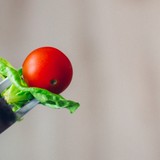Minds and what it eats
Why MSG is not as dangerous as people think.

Traditionally, since Antiquity the basic tastes that distinguish man and his taste buds (by the way, not separately as is usually taught in school, and together), there were four, and each of them determines the chemical characteristics of the products and their interaction with the human body. So, the sour taste is determined by the acidity of the product, salty taste is felt due to the ions of sodium and some other metals (in the people — salt), which are perceived by receptor ion channels on the tongue, and the sweet feeling responsible for the activation of receptors associated with G-proteins, and the same processes are responsible for the bitter taste.
News Why you should abandon the “health food”
Why you should abandon the “health food”
It is curious that a century people felt one more, the fifth taste, or describe, or to call which was not possible prior to the beginning of the last century. That all changed thanks to a Japanese chemist Ikeda, Kikunae, who at the beginning of the XX century worked at the University of Tokyo. The scientist was intrigued by the taste of the Dashi broth used as the basis for many dishes of Japanese cuisine: it can be described as soft, salty, but not salty and is not like any one of the four common tastes.
Dashi is traditionally made on the basis of laminaria algae kombu (Laminaria japonica); Ikeda suggested that from kombu can be a substance that gives it a special taste. The scientist managed to extract the glutamic acid is white crystalline powder, odorless. Its taste Ikeda called umami (jap. 旨味 pleasant): if you can’t remember it East, good examples of foods with umami that Parmesan and dishes flavored with soy sauce.
In order to use glutamic acid for industrial purposes, Ikeda synthesized from soy and wheat protein, salt — monosodium glutamate, which then got the patent. The commercial production of monosodium glutamate (first as a separate condiments) in the early 20-ies of the last century began (under the supervision of icadi), the Japanese company “Ajinomoto”. Since then, the salt of glutamic acid known as a food additive E621 or MSG (from the English. monosodium glutamate), and are mainly used as “amplifiers of taste and smell.”
In Japan and other Asian countries MSG is used to give foods the taste of “umami”, but in Western countries, including in Russia, the supplements, unfortunately, not a good reputation.
Imagine an ordinary trip to the store. Front of buyers — two cans of blueberry yogurt two different manufacturers. The first buyer ask the price and take a jar with a smaller price tag. The second buyer will pay attention to the product description on the label: his choice will define the word “natural”, “bifidobacteria” and “contains natural berries” — let this yogurt will be a little more expensive. Third a buyer, the most delicate and demanding, will return to the lineup, checking for “naturalness”.
News Curcumin helped to keep a clear mind in old age
Curcumin helped to keep a clear mind in old age
What exactly in this case means “naturalness” is difficult to understand, but most people are looking for in the product “E-shki” — used in the manufacture of yoghurt, food additives whose names consist of the letters E and several digits. It is generally believed that the fewer the product more natural.
In a simplified understanding of the third customer is right, choosing a yogurt with the least amount of food additives. In fact, modern food production is rarely complete without the use of additional funds. This, however, does not mean that all of the products “chemicals” and to rid the body of diseases and illnesses, you need to go to the countryside. For example, the majority of food additives of the first category (dyes) are synthesized from natural components — for example, yellow-orange colourings E100, curcumin, obtained from turmeric.